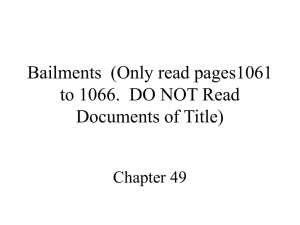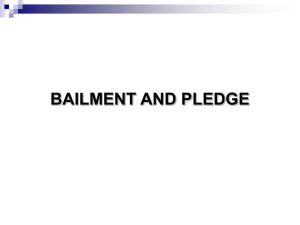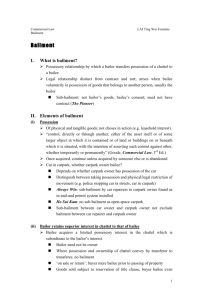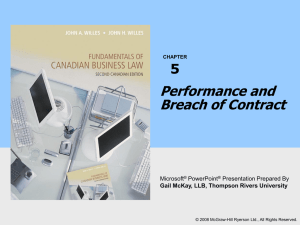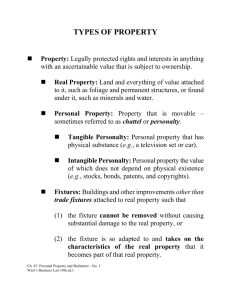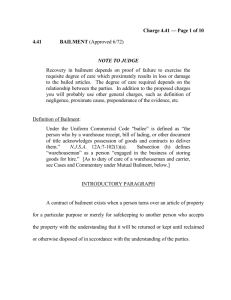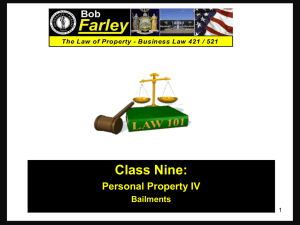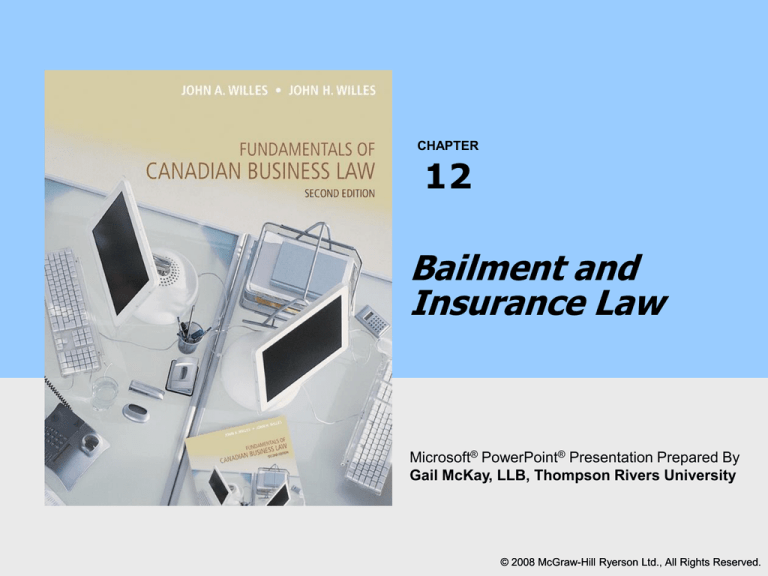
CHAPTER
12
Bailment and
Insurance Law
Microsoft® PowerPoint® Presentation Prepared By
Gail McKay, LLB, Thompson Rivers University
© 2008 McGraw-Hill Ryerson Ltd.
Ltd., All Rights Reserved.
OBJECTIVES
1. To explore the nature of bailment and its
effect on risk allocation in business
2. To examine various forms of bailment
3. To survey various forms of insurance and
their uses in business risk management
4. To examine the nature of insurance and the
concept of indemnity for loss, and to identify
the parties to insurance contracts
Fundamentals of Canadian Business Law, Second Edition
© 2008 McGraw-Hill Ryerson Ltd. All Rights Reserved.
12-1
NATURE OF BAILMENT
A bailment is an express or implied
contractual arrangement having three parts:
1. Delivery of goods by the bailor to the bailee
2. Possession of the goods by the bailee for a
specific purpose
3. An understanding that the goods will be
returned to the bailor at a future time, or
the delivery of the goods according to the
bailor’s directions
Fundamentals of Canadian Business Law, Second Edition
© 2008 McGraw-Hill Ryerson Ltd. All Rights Reserved.
12-2
BAILOR - BAILEE RELATIONSHIP
Delivery of goods to the bailee may be
either a physical or a constructive (implied by
conduct) transfer of possession
Only possession of the goods is transferred,
not title; however a bailee can sue anyone who
wrongfully interferes with the bailor’s goods
The bailee has a duty either to return the exact
goods (or interchangeable commodities) or to
follow instructions for disposition of the goods
Fundamentals of Canadian Business Law, Second Edition
© 2008 McGraw-Hill Ryerson Ltd. All Rights Reserved.
12-3
SUB BAILMENT
A sub bailment generally requires the
previous express agreement of the bailor if
there will be a bailment of the goods on the
part of the bailee to a sub bailee
An exception to the consent requirement arises
if it is the routine custom of the trade to sub
contract to another bailee
A bailee arranging for a sub bailment must
ensure consistency with the terms of the
original bailment to avoid breaching it
Fundamentals of Canadian Business Law, Second Edition
© 2008 McGraw-Hill Ryerson Ltd. All Rights Reserved.
12-4
Fundamentals of Canadian Business Law, Second Edition
© 2008 McGraw-Hill Ryerson Ltd. All Rights Reserved.
12-5
LIABILITY FOR LOSS OR DAMAGE
The standard of care depends on the type of
bailment arrangement, but if goods are lost,
damaged or not returned, the onus shifts to
the bailee since he or she is in the position of
being most likely to know what actually
happened to the goods
To meet this onus, the bailee must
demonstrate that he or she met and
maintained the appropriate standard of care,
and that the harm to or loss of the goods was
not a result of the bailee’s negligence
Fundamentals of Canadian Business Law, Second Edition
© 2008 McGraw-Hill Ryerson Ltd. All Rights Reserved.
12-6
TYPES OF BAILMENT
In a gratuitous bailment, the bailee takes
the goods at no charge and liability depends on
who benefits: if for the benefit of the bailor,
low liability; if for the benefit of the bailee, the
highest liability; if for the benefit of both,
moderate liability
In a bailment for reward, the bailee receives a
fee for holding or handling the goods
In the storage of goods, possession and control
of goods passes to the proprietor of the facility
Fundamentals of Canadian Business Law, Second Edition
© 2008 McGraw-Hill Ryerson Ltd. All Rights Reserved.
12-7
WAREHOUSE STORAGE
A warehouse operator is expected to meet
the reasonable standard of care expected of a
skilled storekeeper, protecting the goods from
all foreseeable risk
A warehouse receipt allows the person who
presents it to claim the bailed goods and,
similarly, a bill of lading (used by carriers)
represents title to the goods
Statutory liens allow a bailee to retain goods
until he or she is paid or, after notice to the
bailor, auction them off
Fundamentals of Canadian Business Law, Second Edition
© 2008 McGraw-Hill Ryerson Ltd. All Rights Reserved.
12-8
PARKING LOTS
Transfer of possession is the key element
that distinguishes a bailment from mere rental
of a parking space – a licence arrangement
If the lot operator either takes the keys and
parks the vehicle, or if the vehicle owner is
directed where to park and then the lot
operator requests the keys, a bailment occurs
Exemption clauses on tickets must be brought
to the attention of the bailor before or at the
time of bailment, or be visible on large signs
Fundamentals of Canadian Business Law, Second Edition
© 2008 McGraw-Hill Ryerson Ltd. All Rights Reserved.
12-9
BAILMENT FOR REPAIR OR SERVICE
Bailment of a chattel left for service or
repair, even though no specific charge is made
for the bailment, nevertheless is viewed as a
bailment for reward creating reasonable
liability for the proprietor
A bailee who professes to have a particular skill
will be held to the standard of care for that skill
A bailee has a common law right of lien against
a chattel owner who does not pay for service
or repair, including the right to auction the
chattel after notice to the bailor
Fundamentals of Canadian Business Law, Second Edition
© 2008 McGraw-Hill Ryerson Ltd. All Rights Reserved.
12-10
RENTAL OF A CHATTEL
When a bailor rents a chattel to a bailee, it
is the temporary possession in exchange for
payment that creates a bailment
The bailee must not use the chattel for any
purposes other than those intended and must
not sub bail the goods without permission
Bailors must ensure the goods provided are fit
for the purpose described by the bailee, are
free from defects and, if the chattel is
inherently dangerous, that appropriate
warnings are provided
Fundamentals of Canadian Business Law, Second Edition
© 2008 McGraw-Hill Ryerson Ltd. All Rights Reserved.
12-11
CARRIAGE OF GOODS
A common carrier is a specialist in the
business of transporting goods for reward and
is therefore held to a high standard of care –
since essentially the company is an insurer of
the goods totally within its care and control for
the duration of the bailment
An act of God, or a bailor’s improper packing or
labelling, would preclude liability of a carrier
A private carrier may transport goods and
must exercise reasonable care over them, but
is not in the business of the carriage of goods
Fundamentals of Canadian Business Law, Second Edition
© 2008 McGraw-Hill Ryerson Ltd. All Rights Reserved.
12-12
Fundamentals of Canadian Business Law, Second Edition
© 2008 McGraw-Hill Ryerson Ltd. All Rights Reserved.
12-13
PLEDGE OF PERSONAL PROPERTY
If a debtor delivers personal property to a
creditor to be held as security for a loan (a
transfer to the creditor which is called a
pledge), a bailment is created
Temporary possession by the bailee is what is
anticipated; but if there is a default on the
loan, the security (usually bonds, share
certificates or life insurance policies) may be
sold – with payment of any surplus to the
debtor
Fundamentals of Canadian Business Law, Second Edition
© 2008 McGraw-Hill Ryerson Ltd. All Rights Reserved.
12-14
INNKEEPERS
Governed by provincial and territorial
statutes, an inn is defined as an establishment
that offers both food and lodging to guests
The statutes require that the liability section of
the legislation be posted in guests’ rooms and
in public areas since it restricts the liability of
the innkeeper for loss or damage to guest
property to between $40 and $100, depending
on the jurisdiction
If valuables are placed in the innkeeper’s vault,
a bailment occurs and the innkeeper is liable
Fundamentals of Canadian Business Law, Second Edition
© 2008 McGraw-Hill Ryerson Ltd. All Rights Reserved.
12-15
FORMS OF INSURANCE
Insurance is an contractual undertaking
by an insurance company (the insurer) to
indemnify a person or business (the insured)
for an agreed consideration from loss or
liability which arises from an event or events,
the occurrence of which is uncertain
It is a form of risk management which shifts
the risk of loss to the insurer for events such
as employee dishonesty, business interruption,
fire, accidents, theft or the death of key
personnel
Fundamentals of Canadian Business Law, Second Edition
© 2008 McGraw-Hill Ryerson Ltd. All Rights Reserved.
12-16
FIRE INSURANCE
The purpose of fire insurance is the
indemnification of any person with an interest
in property for damage or loss that arises as a
result of fire
The scope of loss includes damage to buildings,
equipment, and chattels
The cause of the damage may include the fire
itself as well as smoke, water damage, and
sometimes lightning
Fundamentals of Canadian Business Law, Second Edition
© 2008 McGraw-Hill Ryerson Ltd. All Rights Reserved.
12-17
LIFE INSURANCE
The purpose of life insurance is the
protection of beneficiaries by insuring either
one’s own life or the life of another person in
whom one has an insurable interest
The application for insurance is an utmost good
faith document which allows the insurer to
assess the risk of insuring the potential insured
and to determine how much the premium for
the policy should be
Statements discovered to be fraudulent allow
the insurer to avoid payment under the policy
Fundamentals of Canadian Business Law, Second Edition
© 2008 McGraw-Hill Ryerson Ltd. All Rights Reserved.
12-18
OTHER FORMS OF INSURANCE
Sickness and accident insurance has the
purpose of reducing income loss that arises
from illness or accident and may be provided
as part of a benefits package by an employer
Liability and negligence insurance is intended
to indemnify a business or person for claims
made by others about the performance of their
work, including professional errors and
omissions, environmental accidents, occupiers’
liability, manufacturers’ product liability and
automobile accident liability
Fundamentals of Canadian Business Law, Second Edition
© 2008 McGraw-Hill Ryerson Ltd. All Rights Reserved.
12-19
THE NATURE OF AN INSURANCE POLICY
Changes in standard form contracts of
insurance are made by means of either a rider
or additional clause added at the time the
contract is created, or alternatively by means
of an endorsement - a change to an existing
contract which saves rewriting the original one
An insurable interest is defined as a financial
interest that would result in a loss to the
insured on the occurrence of some event, but
excludes a wilfull act on the part of the insured
against themselves or an insured interest
Fundamentals of Canadian Business Law, Second Edition
© 2008 McGraw-Hill Ryerson Ltd. All Rights Reserved.
12-20
NATURE OF POLICY, continued
An insurable interest must exist both at the
time the contract of insurance is made and
when the event occurs that causes the loss
The one exception to this rule is a contract for
life insurance
There is also one exception to the full
disclosure rule for utmost good faith insurance
contracts: innocent misrepresentation (or
innocent non disclosure)
Fundamentals of Canadian Business Law, Second Edition
© 2008 McGraw-Hill Ryerson Ltd. All Rights Reserved.
12-21
CHANGE OF RISK
Notification is required from the insured to
the insurer if there is to be a substantial
change in the property itself or to the type of
business carried on there
The notification allows the insured to decide if
it still wishes to provide coverage for the
business, and if so, what the change in the
amount of the premium should be
Fundamentals of Canadian Business Law, Second Edition
© 2008 McGraw-Hill Ryerson Ltd. All Rights Reserved.
12-22
THE CONCEPT OF INDEMNITY FOR LOSS
Indemnity permits an insured business to be
placed in the position it would have been in
prior to the loss, but not to make a profit
An insurer has 3 rights respecting the insured’s
losses: salvage, if the insurer has paid the
insured the value of the goods; subrogation, if
the insurer has compensated the insured for
loss and wishes to sue the third party who
caused it; and contribution, if there are 2
policies covering the same loss, the insurers
have the right to share indemnification for the
loss between themselves
Fundamentals of Canadian Business Law, Second Edition
© 2008 McGraw-Hill Ryerson Ltd. All Rights Reserved.
12-23
Fundamentals of Canadian Business Law, Second Edition
© 2008 McGraw-Hill Ryerson Ltd. All Rights Reserved.
12-24
PARTIES ASSOCIATED WITH INSURANCE
Agents of the insurer negotiate insurance
contracts and are liable to insurers; if an
insured relies on an agent’s word that a risk is
covered, he or she can sue the agent if it is not
Brokers, who may work for either party,
determine risks and complex insurance needs
and seek insurers who will provide coverage
Insurance adjusters investigate reported losses
on behalf of the insurer and then assess the
extent of the loss; insurers use this amount to
make an offer to settle the claim
Fundamentals of Canadian Business Law, Second Edition
© 2008 McGraw-Hill Ryerson Ltd. All Rights Reserved.
12-25
SUMMARY
Bailment is the temporary transfer of
possession, but not title, to goods - either
gratuitously or for reward
Bailment for reward includes storage, carriage
of goods, deposit of goods for repair, rental of
goods, and the pledge of securities for a loan
Insurance is used to indemnify an insured with
an insurable interest at the time of contract
formation and the time of the event causing
the loss; after indemnification, the insurer has
salvage, subrogation and contribution rights
Fundamentals of Canadian Business Law, Second Edition
© 2008 McGraw-Hill Ryerson Ltd. All Rights Reserved.
12-26


